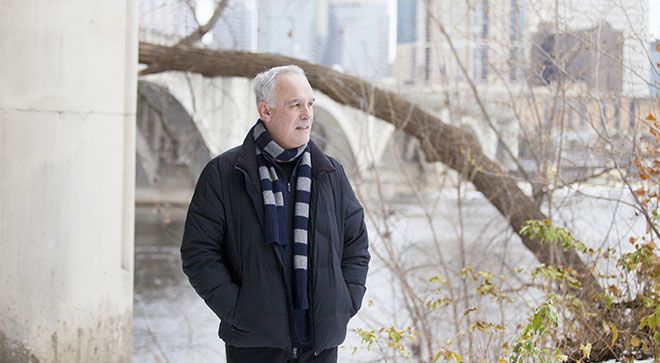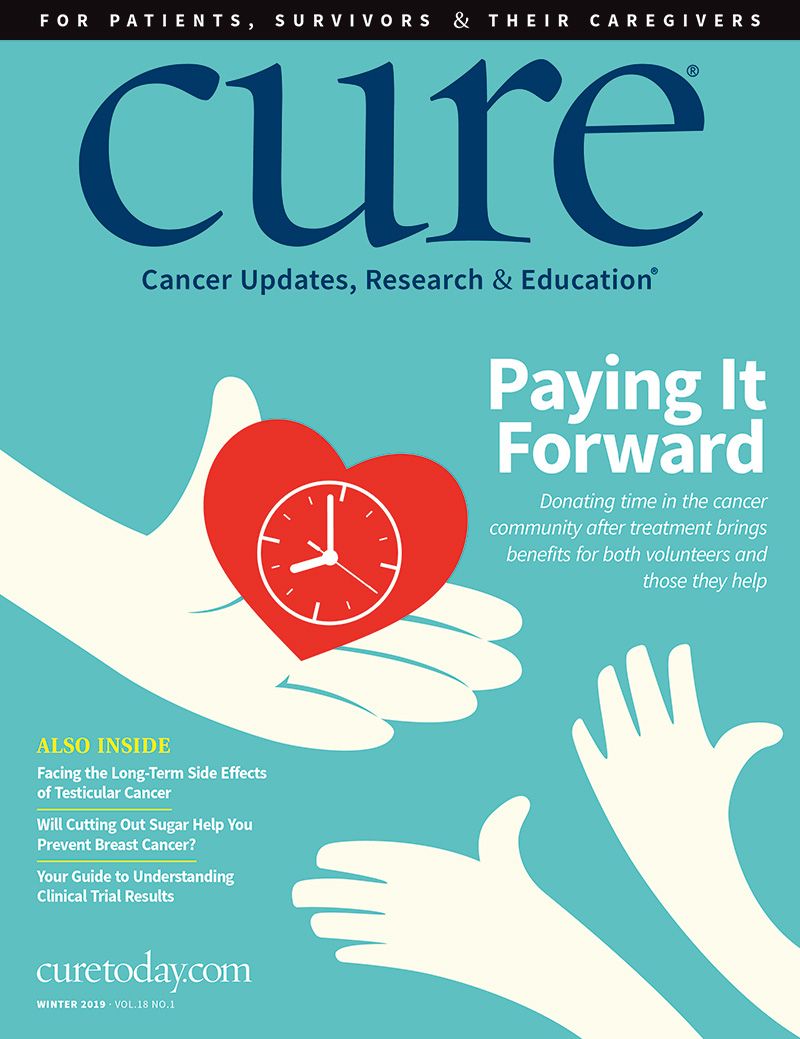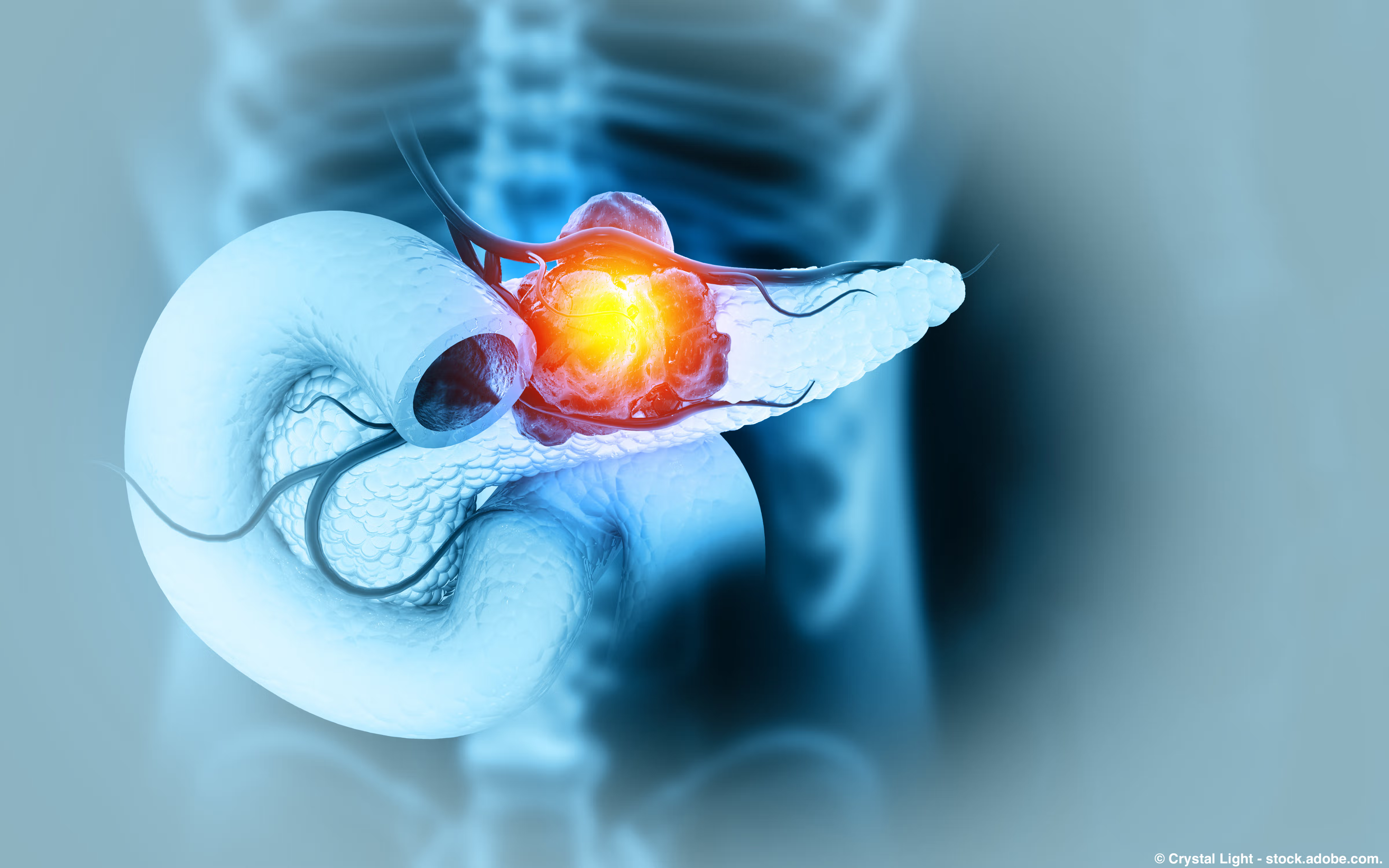Publication
Article
CURE
Beyond the Norm
Author(s):
A number of approved therapies can be used to treat pancreatic cancer, but many experts say that clinical trials offer patients greater hope.
When Scott Nelson learned he had pancreatic cancer in 2004, he immediately entered a clinical trial. Although his cancer had been caught early, it wasn’t early enough for him to undergo a Whipple procedure, the surgical removal of a pancreatic tumor. The 65-year-old retired financial services executive lives in Minneapolis, so his physician sent him to the University of Minnesota, where he met the criteria for a trial that included cisplatin and fluorouracil chemotherapies; interferon alpha, an immunotherapy; and radiation.
“The clinical trial was relatively successful, but patients were having a difficult time with the treatment, given the toxicity,” Nelson says. Still, the drugs worked for him: The chemotherapy shrank his tumor enough for a Whipple in late 2004, which fully removed his cancer. After six years of regular scans for recurrence, Nelson — today an active patient advocate — now undergoes surveillance scans just every couple of years.

Scott Nelson credits a regimen he took in a clinical trial with eliminating his pancreatic cancer.
Several factors worked in Nelson’s favor. First, he lived near an academic center running clinical trials, and he met the criteria to enter one right away. Then, the trial itself involved a platinum-based chemo­therapy agent, and Nelson had a BRCA gene mutation. The link between BRCA1 and BRCA2 mutations and pancreatic cancer is well established today, but 14 years ago, scientists didn’t know that 4 to 15 percent of people with pancreatic cancer have at least one of 11 identified gene mutations, with both BRCA mutations in that group — nor was it known that, for unclear reasons, people with a BRCA mutation respond best to platinum-based chemotherapy. Finally, the therapy worked despite its toxicity.
Nelson joined the very small proportion of people who have survived one of the most recalcitrant cancers. The key to his survival was joining a clinical trial, which many believe should be the standard of care for pancreatic cancer.
“Especially with a disease where the standard of care itself leads to improvements of just three to five months, I think it’s fitting to say we need a better standard of care,” says Anirban Maitra, M.B.B.S., a professor of translational molecular pathology and scientific director of the Sheikh Ahmed Bin Zayed Al Nahyan Center for Pancreatic Cancer Research at The University of Texas MD Anderson Cancer Center in Houston. “The way to do that is clinical trials. The only way we’re going to make progress is by trying new combinations and new classes of drugs.”
Pancreatic cancer is the third leading cause of cancer death in men and women and accounts for 7 percent of all cancer deaths. The vast majority (94 percent) of cancers of the pancreas are adenocarcinomas that arise from the glandular organ’s exocrine part, which produces digestive enzymes. The rest include rarer types of exocrine tumors or, in less than 1 percent of cases, a tumor in the endocrine part, which produces metabolism-regulating hormones, including insulin.
One reason pancreatic cancer is so tough to beat is that 90 percent of cases involve the particularly troublesome RAS mutation. Despite being the first human cancer-causing gene mutation found — and the most common — RAS has eluded scientists working to develop a targeted therapy against it.

Scott Nelson is glad to be healthy enough after pancreatic cancer to hike and bike the trails along the river and bridge in downtown Minneapolis, where he lives.
Another reason for the low survival rate is that few patients qualify for surgery, referred to as resection. The standard of care starts with using MRI and other imaging to determine whether the tumor is operable. That depends on its stage, size and placement, including how close it is to blood vessels.
But fewer than one in five patients’ cancer can be operated on because the disease is nearly always detected too late, Maitra says. And once the disease has spread, the length of anticipated survival drops.
“Cancer is not very fast-growing initially. It’s only after diagnosis that you think it’s fast-growing,” says Pinku Mukherjee, Ph.D., a professor and chair of cancer biology and immunology at the University of North Carolina at Charlotte. “It’s actually in your body for a long time. That’s why early detection is the key.”
But no universal screening program for pancreatic cancer currently exists, and symptoms, such as lower back pain, weight loss and gastrointestinal complaints, are vague enough to resemble many other conditions.
Patients who do undergo a Whipple — a difficult procedure requiring a surgeon with specialized experi­ence — receive postsurgical, or adjuvant, chemotherapy. Radiation is not frequently used except in select patients whose pre-op indicates it could benefit them by making the tumor’s edges more distinct so the mass is easier to fully remove, Maitra says. According to the Pancreatic Cancer Action Network, radiation is also sometimes used to relieve pain caused by the tumor or destroy any leftover cancer cells after surgery.
The two first-line chemotherapy options for those with inoperable tumors are gemcitabine plus nab-paclitaxel or a combination of fluorouracil, leucovorin, irinotecan and oxaliplatin called FOLFIRINOX.
For those who undergo a Whipple, FOLFIRINOX is a new post-surgical option being used based on the findings of the PRODIGE 24 study, announced last year at the annual meeting of the American Society of Clinical Oncology (ASCO), Maitra says. Gemcitabine plus nab-paclitaxel is also being studied post-surgically, but results have not yet been reported.
Though not officially recognized as the current standard of care, giving chemotherapy before surgery is increasingly common. This neoadjuvant therapy increases the likeli­hood that surgeons can remove the entire tumor, with no cancer cells lingering behind.
IMPROVING CHEMOTHERAPY
Even in a patient whose tumor is removed, however, chemotherapy rarely buys much more than two years of survival — just a few extra months in someone with inoperable tumors — and the cancer typically recurs within two years, Maitra says. So, researchers have continued seeking new chemotherapy combinations to boost survival.
The PRODIGE 24 findings were an eye-opener that did exactly that, resulting in increased survival that, according to Maitra, was “unheard of with pancreatic cancer.”
At 30.5 months of follow-up in this randomized phase 3 trial, patients receiving a modified FOLFIRINOX regimen lived a median of 20 months longer — 54.4 months compared with overall survival of 35 months for those who took gemcitabine. Disease-free survival — the length of time before recurrence — was 21.6 months in the FOLFIRINOX group and 12.8 months in the gemcitabine group.
“A lot of people were very pleasantly surprised by seeing this data,” Maitra says. “At least in academic centers moving forward, I think more and more we’re going to try FOLFIRINOX in the adjuvant setting and see how that impacts survival.”
Another encouraging development reported at ASCO’s annual meeting involved outcomes for presurgical therapy in those with borderline resectable pancreatic adenocarci­noma, a practice that drew skepticism when MD Anderson pioneered it. The biggest argument against neoadjuvant therapy was that waiting to resect the tumor — even to deliver chemoradiation — risked giving the cancer time to metastasize so much that it was no longer operable, Maitra says. But that’s not what happened.
The Dutch phase 3 PREOPANC-1 study randomly assigned 246 participants to either go straight to surgery or receive gemcitabine with radiation before surgery. Both groups received chemotherapy after resection, but overall survival was 17.1 months in the group that received gemcitabine and radiation beforehand, compared with 13.5 months in those without preoperative chemotherapy. Disease-free survival was similarly longer in those who had presurgical therapy, a median of 11.2 months compared with 7.9 months in the surgery-first group.
Though preliminary, these findings are exciting, Maitra says, because they confirm longer survival for patients receiving neoadjuvant therapy without affecting the ability to undergo resection. Giving patients chemoradiation before surgery makes the separation between tumor cells and healthy cells more distinct, he explains, so it’s easier for the surgeon to remove all the cancer without leaving behind pieces too small to see without a microscope.
Both these trials, however, offer good news only for those with resectable tumors — again, a minority of people with pancreatic cancer.
LOOKING BEYOND CHEMOTHERAPY
Joining a clinical trial also opens up patients’ options beyond chemotherapy combinations. Although some patients live many years receiving only chemotherapy, they are exceptions — and toxicity remains a concern.
Mukherjee says that future treatments need to focus on targeted drugs and immunotherapies, though the timetable for their development can’t be predicted. People whose tumors have microsatellite instability (MSI) respond more often to current immunotherapy, but make up just 1 percent of pancreatic cancer cases. MSI status means the DNA sequences in cancer cells have been altered due to a defect in the cells’ ability to repair mistakes made when DNA is copied.
“I think the way to go with pancreatic cancer has to be immunotherapy, and for that, there has to be earlier diagnosis than is happening right now,” Mukherjee says.
“With immunotherapy, the promise is that you can generate memory immune cells that, when a tumor comes back, are already armed to fight it.”
Researchers are also looking into combining oncolytic, or engineered, viruses with other treatments to fight pancreatic cancer. The strategy involves using these viruses to induce an immune response, similar to what a vaccine does, except the response breaks down the cancer cells and releases proteins called antigens that the body can learn to recognize and attack.
Oncolytic viruses may also help overcome a chal­lenge with immunotherapies: “cold” tumors that lack functioning T cells. Without the T cells that attack intruders, an immune response won’t succeed. With pancreatic cancer, the tumor often is surrounded by thick tissue called stroma, which acts like a moat around a castle to keep out T cells. Scientists are working on ways to break up the stroma and allow an influx of T cells, making the tumor “hot” and more responsive to immunotherapy.
One of the biggest areas of study combines existing chemotherapy regimens with new agents, such as PARP inhibitors and drugs in other classes: Onivyde (irinotecan), PEGPH20 and napabucasin (BBI-608).
PARP inhibitors take advantage of the inability of a cancer cell’s DNA to repair itself, says Tanios Bekaii-Saab, M.D., a professor of medicine at Mayo Clinic in Phoenix. “You break it, and if it can’t repair itself, then the cancer cell dies,” he says. “Out of all the subsets of pancreatic cancer other than MSI-high, this is one of the subsets where we’re going to be able to move the needle pretty aggressively.”
PARP inhibitors under investigation include veliparib (ABT-888); Lynparza (olaparib), which is already approved to treat breast and ovarian cancers; and Rubraca (ruca­parib). Veliparib shows almost no activity, but the other two are very promising, Bekaii-Saab says. People with the BRCA1 and BRCA2 mutations — 5 to 15 percent of patients — tend to be most sensitive to this approach, but Bekaii-Saab hopes to expand the group who could benefit by adding DNA-damaging chemotherapies.
“The challenge has been that when you combine the more potent and active PARP inhibitors with chemo­therapy, the toxicity increases,” he says. Without the extra toxicity, the DNA doesn’t sustain enough damage. With the toxicity, the patient suffers.
Enter Onivyde, a nanoliposomal formulation of the chemotherapy irinotecan. This drug was recently approved by the Food and Drug Administration and may be effective in combination with PARP inhibitors, Bekaii-Saab says. Its unique formulation allows it to almost completely leave healthy organs within 48 hours while continuing to accumulate in the tumor, he explains, minimizing overall toxicity while maximizing benefit.
Another approach combines the experimental therapy PEGPH20 (peghyaluronidase alfa) with gemcitabine and nab-paclitaxel in people with high levels of hyaluronan, or hyaluronic acid. “Hyaluronic acid is one of the main backbones of the stroma, the environment that makes the pancreatic tumor very compact and difficult to penetrate,” Bekaii-Saab says. The drug targets the enzyme that forms hyaluronic acid. “PEGPH20 breaks down that hyaluronic acid to facilitate chemo into the tumor site,” he says.
Patients with high levels of hyaluronan gained three months of life in a trial of PEGPH20 published in 2017, lending validation to an ongoing phase 3 trial, but toxicity remains a concern.
Another combination is gemcitabine and nab-paclitaxel with napabucasin (BBI-608), an oral STAT3 inhibitor that targets the drivers of “stemness,” a cell’s ability to withstand chemotherapy and renew itself. Cancer cells that survive chemotherapy are thought to revert to this more aggressive, hardy cell type. Napabucasin targets the pathways involved in that reversion to prevent stemness and keep cells sensitive to chemotherapy. In a study led by Bekaii-Saab, 66 patients received napabucasin with gemcitabine and nab-pacli­taxel; 55 percent responded, leading to a phase 3 trial that aims to recruit more than 1,100 patients.
But these baby steps — combining new agents with existing chemotherapy — don’t lead to help for the vast majority of people with this disease, according to Nelson. “If most of your research is focused on how to make the treatment incrementally better, then you’re missing most of the people,” he says. “Let’s look upstream on prevention and then downstream on the recurrence rates and people surviving this.”
MORE ROBUST SCREENING
It’s not currently recommended that all patients with pancreatic cancer undergo germline testing for mutations, but that approach is increasingly likely to become standard soon, experts say.
Until recently, less than 10 percent of patients with pancreatic cancer underwent that testing, per National Comprehensive Cancer Network (NCCN) Guidelines, but some experts now believe that everyone with the disease should be tested. One reason: A rising number of patients with germline (inherited) mutations do not match the expected profile — for instance, they may not have a family history of the disease.
“We are clearly missing patients that have germline muta­tions because we were following rigorous guidelines that may have been too restrictive,” Maitra says. Another reason for increased testing is simply that the cost has dropped so much, from several thousand dollars to as low as $250. “So, with that kind of a price range and the scientific evidence showing that patients were clearly being missed who had deleterious germline mutations, most commonly in BRCA2, I think we’re going to find a lot more patients who have mutations that were unsus­pected,” Maitra says.
Patients’ family members can also undergo testing to learn if they have a mutation and potentially enter a screening program. That’s exactly what saved Nelson’s brother’s life: He had a mutation and entered a surveillance study at Mayo Clinic, where some suspicious spots on his pancreas were monitored for eight years. The spots didn’t change, but doctors detected early cancer cell development else­where on his pancreas that led to a Whipple. “His cancer risk is gone now because of surveillance,” Nelson says. Testing direct relatives of mutation carriers and then the direct relatives of those who test positive is known as cascade testing, and the opportunity to conduct it is frequently missed in the immediate aftermath of a pancreatic cancer diagnosis.
Facilitating cascade genetic testing for family members of patients with pancreatic cancer who harbor a germline mutation is one component of a new Cancer Interception initiative led by Maitra and funded by Stand Up to Cancer and the Lustgarten Foundation for Pancreatic Cancer Research. A big part of the initiative focuses on finding the cancer before it has time to wreak irrevocable havoc: doing universal screening for inher­ited mutations in all patients with pancreatic cancer, using machine learning with a huge database of images to improve detection, testing a new vaccine to prevent pancreatic cancer, and developing screening blood tests to detect risk and early disease.
Nelson is involved as a patient advocate. After 14 years of watching incremental progress with no major shifts in survival, he sees the initiative as a major opportunity to make real progress in the fight against pancreatic cancer. “I’m much more excited and hopeful than I’ve ever been,” he says.





